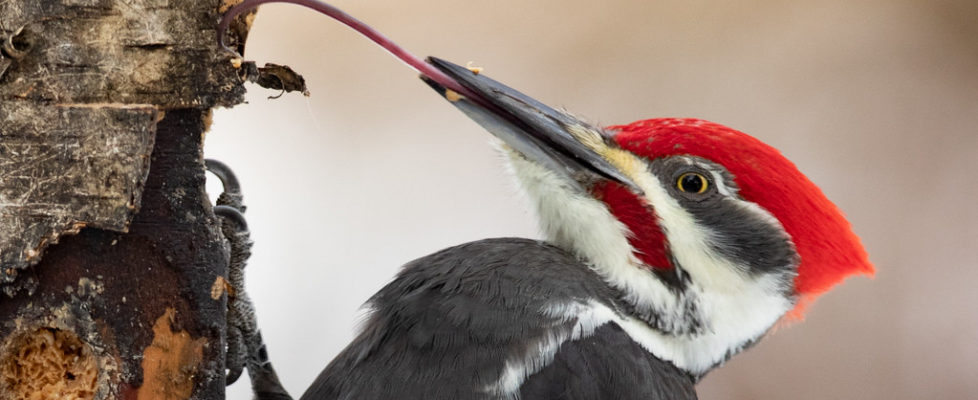The Tongue Tells the Tale
Today I’m going to spend some time marveling at woodpeckers. In fact, I’m going to marvel at just one part of them: their tongues.
Not that there aren’t plenty of other things worth noticing, starting with the fact that woodpeckers are one of the most diverse groups of birds in Westchester. (And one of the most noticeable and familiar: Every species can become part of our backyard-birding experience, especially during migration season.)
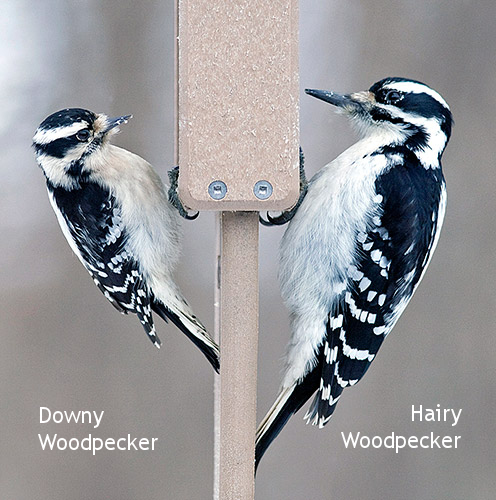
Six species are at least fairly common nesters in this region: the ladder-backed Downy and its bigger cousin, the Hairy; that comparatively recent invader from the south, the Red-Bellied; the quiet and little-seen Yellow-Bellied Sapsucker; the Northern Flicker; and the magnificent, crow-sized Pileated.
That’s a lot of woodpeckers. (By comparison, our region hosts just one chickadee and titmouse and two orioles and tanagers.) But woodpeckers offer more than variety and a percussion soundtrack to a walk in the spring woods. They also serve as spectacular examples of adaptive evolution. There’s so much to say that I’ll focus on three of them: the Flicker, Sapsucker, and Pileated. (I pronounce that “PILL-e-ay-ted,” by the way.)
These three species—like all woodpeckers—eat grubs, ants, and other insects, most often obtained through excavation into tree trunks or limbs. To make this possible, woodpeckers share important features: sharp chisel-like beaks, powerful neck muscles, a thick skull, and a brain designed not to be bruised by repeated impacts.
But the differences in their tongues tell us even more. In each case, the tongue’s length and structure helps reveal where each species hunts, the techniques it uses, and even its preferred prey.
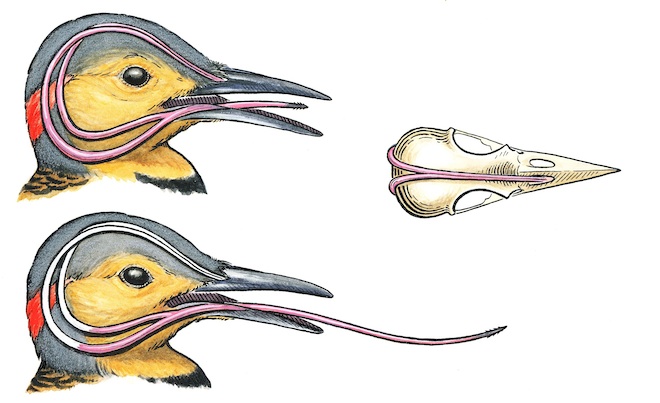
Woodpeckers all tend to have surprisingly long tongues, which are usually stored, remarkably, in a chamber between the back of the bird’s skull and its skin. But Pileateds’ tongues are relatively short, and for a simple reason: The birds’ physical strength and powerful beaks allow them to excavate deeply, reaching their prey without needing an extremely long tongue to do so.
Pileateds’ preferred food includes large grubs and carpenter ants, which can reach nearly half an inch in length. To capture these sizable insects most efficiently, the tip of the Pileated’s tongue is covered with backward-facing barbs. In essence, the bird goes fishing, dipping its tongue into an excavation, hooking its prey, and yanking it out.
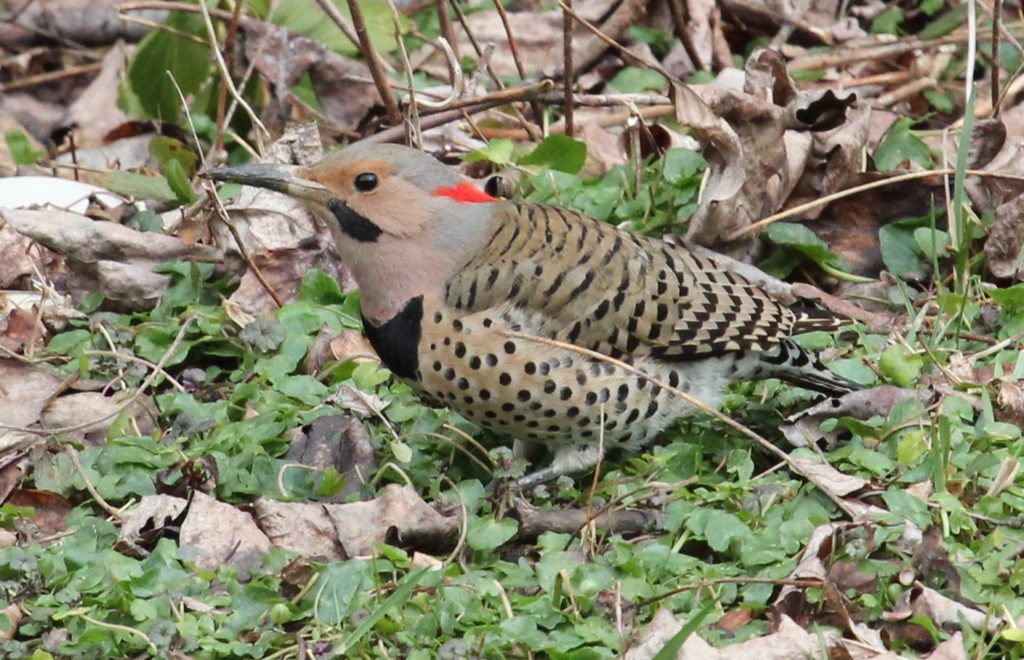
Northern Flickers, on the other hand, rarely excavate in wood at all. They’re much more likely to be seen on the ground, digging into ant colonies. Since the ants they eat are of the smaller varieties, Flickers’ tongues are flattened to provide a greater surface area, but have few barbs.
Like anteaters, which also feast on small ant and termites, Flickers have evolved another useful trait: sticky saliva. The flat, sticky tongue efficiently allows the woodpecker to retrieve a large number of ants at a time.
Yellow-Bellied Sapsuckers have yet another approach to food. In fact, Sapsucker adaptations may be the most fascinating and complex of all.
As their name suggests, Sapsuckers actually do eat sap taken from a variety of trees. (Their favorites range from paper birch to swamp maple to pines and other conifers.) But they do more than just eat the sap: They farm it.
Many of us recognize a row of small, circular holes neatly arrayed in lines on a tree trunk as a sapsucker’s work. One tree may have dozens or even hundreds of holes, located from near ground level high up the trunk.
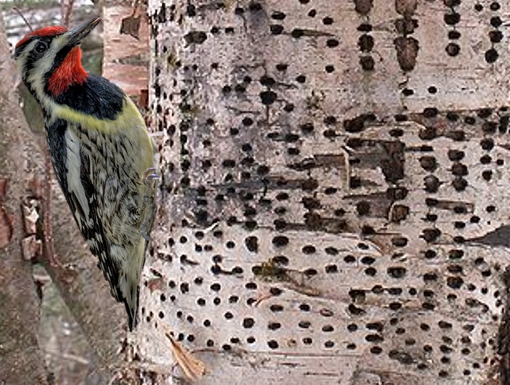
These holes were not drilled in search of insect prey. They are the “sap wells” of a Yellow-Bellied Sapsucker, drilled specifically to give them access to running sap, which the bird eats. Each sapsucker maintains a territory with its own sap well farm, which it will tend each day and defend against others (including other sapsuckers) that might want to exploit it.
Sap is not the only food this woodpecker relies on. As uneaten sap dries and hardens, it can trap small insects, which become part of the bird’s diet. At certain times of year, especially fall and winter when insects are scarce, the sapsucker will augment its diet with seeds, fruit, and bast (the soft inner wood of a tree trunk or stem). But even here the sap wells play a role: The bast comes from the interiors of the holes they’ve drilled.
Adult sapsuckers feed their young sap and insects as well. Remarkably, researchers have observed parent birds catching a butterfly or other insect, then dipping it in the sap before delivering it to the babies. Presumably, this adds nutritional value to the meal.
What do sapsucker tongues have to do with all this? Plenty. Neither the Pileated’s spear- and fishhook-like tongue nor the Flicker’s flattened, sticky one is designed for transferring a flowing liquid to the bird’s mouth.
But the sapsucker’s tongue is exquisitely well suited to the task. The Yellow-Bellied’s tongue has feather-shaped bristles near the tip, converting it into a kind of sap-collecting brush. Importantly, the tongue’s bristles can hold the liquid more readily through the process known as capillary action. (The same way paint spreads between the bristles of a paintbrush.)
Beyond these three species, each of our other familiar woodpeckers also has its own unique story to tell. Meanwhile worldwide, more than 200 woodpecker species—large and small, spectacular and unobtrusive—occupy tropical jungles and boreal forests, high mountain slopes and sere deserts on every continent save Antarctica.
To see how they do it, just take a look at their tongues.
Copyright © 2020 by Joseph Wallace
